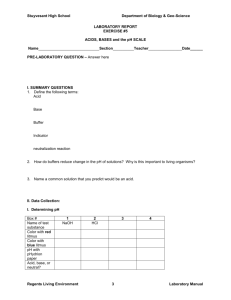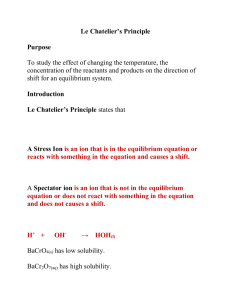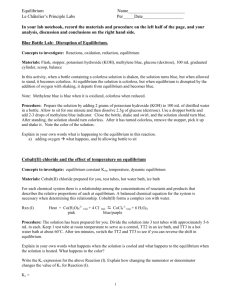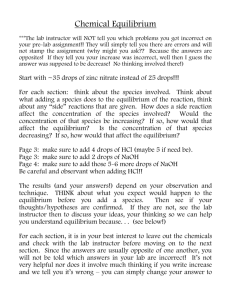Le Chatelier's Principle AP Chemistry Lab #16
advertisement
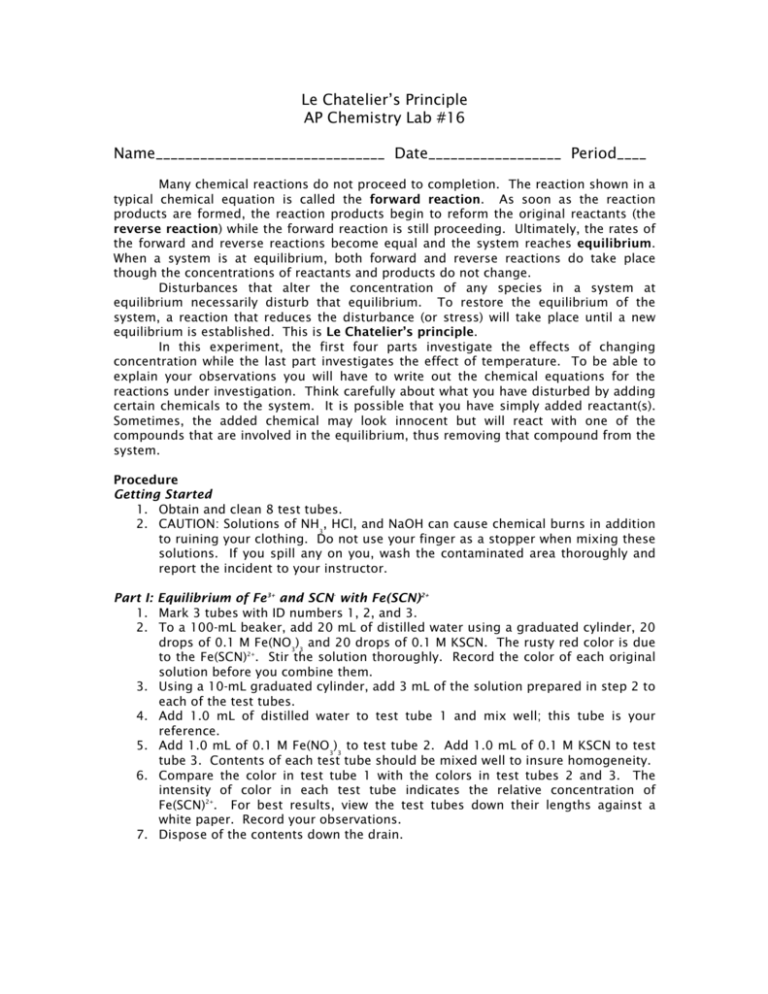
Le Chatelier’s Principle AP Chemistry Lab #16 Name_______________________________ Date__________________ Period____ Many chemical reactions do not proceed to completion. The reaction shown in a typical chemical equation is called the forward reaction. As soon as the reaction products are formed, the reaction products begin to reform the original reactants (the reverse reaction) while the forward reaction is still proceeding. Ultimately, the rates of the forward and reverse reactions become equal and the system reaches equilibrium. When a system is at equilibrium, both forward and reverse reactions do take place though the concentrations of reactants and products do not change. Disturbances that alter the concentration of any species in a system at equilibrium necessarily disturb that equilibrium. To restore the equilibrium of the system, a reaction that reduces the disturbance (or stress) will take place until a new equilibrium is established. This is Le Chatelier’s principle. In this experiment, the first four parts investigate the effects of changing concentration while the last part investigates the effect of temperature. To be able to explain your observations you will have to write out the chemical equations for the reactions under investigation. Think carefully about what you have disturbed by adding certain chemicals to the system. It is possible that you have simply added reactant(s). Sometimes, the added chemical may look innocent but will react with one of the compounds that are involved in the equilibrium, thus removing that compound from the system. Procedure Getting Started 1. Obtain and clean 8 test tubes. 2. CAUTION: Solutions of NH3, HCl, and NaOH can cause chemical burns in addition to ruining your clothing. Do not use your finger as a stopper when mixing these solutions. If you spill any on you, wash the contaminated area thoroughly and report the incident to your instructor. Part I: Equilibrium of Fe3+ and SCN- with Fe(SCN)2+ 1. Mark 3 tubes with ID numbers 1, 2, and 3. 2. To a 100-mL beaker, add 20 mL of distilled water using a graduated cylinder, 20 drops of 0.1 M Fe(NO3)3 and 20 drops of 0.1 M KSCN. The rusty red color is due to the Fe(SCN)2+. Stir the solution thoroughly. Record the color of each original solution before you combine them. 3. Using a 10-mL graduated cylinder, add 3 mL of the solution prepared in step 2 to each of the test tubes. 4. Add 1.0 mL of distilled water to test tube 1 and mix well; this tube is your reference. 5. Add 1.0 mL of 0.1 M Fe(NO3)3 to test tube 2. Add 1.0 mL of 0.1 M KSCN to test tube 3. Contents of each test tube should be mixed well to insure homogeneity. 6. Compare the color in test tube 1 with the colors in test tubes 2 and 3. The intensity of color in each test tube indicates the relative concentration of Fe(SCN)2+. For best results, view the test tubes down their lengths against a white paper. Record your observations. 7. Dispose of the contents down the drain. Part II: Equilibrium of Ni2+ and NH3 with Ni(NH3)62+ 1. Add 10 drops of 0.1 M Ni(NO3)2 to a clean test tube. Record the color. 2. Obtain the 6 M NH3 and the 6 M HCl and record the appearance of each. 3. Add drops of 6 M NH3 until the color changes and intensifies. Record the color. 4. Add drops of 6 M HCl until the color changes once again. Record the color. 5. Discard in the “HCl waste” beaker; do not pour down the drain. Part III: Equilibrium involving phenolphthalein 1. Mark 2 tubes with acid and base. 2. Add 3 mL of distilled water to both tubes. 3. Add 4 drops of 6 M HCl to the acid tube and 4 drops of 6 M NaOH to the base tube. Gently swirl each tube to mix well. Record the color of each original solution. 4. Add 4 drops of indicator to the acid tube. Shake gently. Record the color. 5. Now add drops of NaOH solution until the color changes. Record your observations. 6. Add 4 drops of indicator to the base tube. Shake gently. Record the color. 7. Now add drops of HCl solution until the color changes. Record your observations. 8. Discard the solutions in the “HCl waste” beaker. Part IV: Solubility of Ca(OH)2 1. Using a 10-mL graduated cylinder, add 2 mL of 6 M NaOH to a small, clean test tube. Record the color. 2. Rinse the cylinder and use it to add 1 mL of 1 M Ca(NO3)2 to the tube. Record the initial color of the Ca(NO3)2 before adding it to the tube. 3. Stir the mixture thoroughly with a stirring rod. A white precipitate of Ca(OH)2 should be present. Record your observations. 4. Add 6 M HCl dropwise to the precipitate, stirring after each drop is added, until the precipitate dissolves. Record your observations. 5. Add 6 M NaOH dropwise to the solution with stirring until the precipitate forms again. Record your observations. 6. Discard the solution in the “HCl waste” beaker. Part V: Equilibrium of Co2+ and Cl- with CoCl421. Check to make sure that the water is heated to a gentle boil. 2. Place 5 drops of 0.15 M CoCl2 in a clean test tube. Record the color. 3. CAUTION: Your goggles MUST be over your eyes while you perform the next step!! Concentrated HCl is corrosive and it may burn your skin and make numerous holes in your clothing. If you get any on your hand, wash the affected area with copious amounts of cold tap water and report the incident to your instructor. Take the tube to the fume hood and add 7-8 drops of concentrated (12 M) HCl (record its color). Shake the test tube gently and record the color. This is the characteristic color of the CoCl2ion. 4 4. Add drops of distilled water one drop at a time until the color changes. Shake gently after each drop is added. Record your observations. 5. Place the test tube in the boiling water (use test tube holder to secure the tube) and wait a few minutes until the color has changed again. Record your observations. 6. Cool the test tube in cold water (from the tap) until the color changes once more. Record the color. 7. Discard the solution in the waste beaker located under the fume hood. Analysis Questions 1. Questions pertaining to part I: a. Write the net ionic equation for the equilibrium reaction in part I. Assign a color to each ion. b. How did the color of test tube 2 compare to test tube 1? Use Le Chatelier’s principle to explain your observations. c. How did the color of test tube 3 compare to test tube 1? Use Le Chatelier’s principle to explain your observations. 2. Questions pertaining to part II: a. Write the net ionic equation for the equilibrium reaction in part II. Assign a color to each ion. b. How did the color change when NH3 was added to the test tube? Why? c. How did the color change when HCl was added to the test tube? Write an additional equation to show how HCl was able to shift this equilibrium. Use Le Chatelier’s principle to explain your observations. 3. Questions pertaining to part III: a. Write the equation for the equilibrium reaction in part III. Use “HIn” to represent the acid form of the indicator and “In-“ to represent the base form. Assign a color to each form. b. Did the color of the HCl change when the phenolphthalein was added to it? Use Le Chatelier’s principle to explain why or why not. c. Did the color in the acid test tube change when NaOH was added to it? You’ll need to write an additional equation here to explain why/why not (using Le Chat, of course!). d. What did you observe when phenolphthalein was added to the NaOH. Explain. e. What did you observe when HCl was added to the base test tube. Explain. 4. Questions pertaining to part IV: a. Write the equation (not an equilibrium) showing the formation of the precipitate in part IV. Assign colors to the reactants and products. b. Now write an equilibrium equation showing the solid (as a reactant) in equilibrium with its ions in water. c. What did you observe when you added HCl to the precipitate? Use Le Chat and an extra equation to explain. d. What did you observe when you added NaOH? Use Le Chat to explain. 5. Questions pertaining to part V: a. Write the net ionic equation for the equilibrium reaction in part V. Assign a color to each ion. b. Write out the equilibrium constant expression for the reaction. c. How did the color change when water was added? Explore how Q changes when you dilute the solutions, and use that information as well as Le Chatelier’s principle to explain why the addition of water caused the color change. What’s the general rule here? d. How did the color change when the system was heated? When it was cooled? Explain how you can use this information (and Le Chat) to determine if the reaction was exothermic or endothermic. Data Tables Part I: Equilibrium of Fe3+ and SCN- with Fe(SCN)2+ Solution Appearance Fe(NO3)3 KSCN Test Tube 1 ( Part II: Equilibrium of Ni2+ and NH3 with Ni NH3 Solution Ni(NO3)2 NH3 ) Test Tube 2 Test Tube 3 HCl (Ni2+ + NH3) + HCl 2+ 6 Ni2+ + NH3 Appearance Part III: Equilibrium of HCl and NaOH with phenolphthalein Solution HCl NaOH HCl + ph (HCl/ph) + NaOH NaOH + ph (NaOH/ph) + HCl Appearance Part IV: Solubility of Ca(OH)2 Solution NaOH Ca(NO3)2 NaOH + Ca(NO3)2 Appearance + HCl + NaOH Part V: Equilibrium of Co2+ and Cl— with CoCl2− 4 Solution Appearance CoCl2 HCl CoCl2 + HCl + H2O Heated Cooled Le Chatelier’s Principle AP Chemistry Lab #16 Prelab Questions Name_______________________________ Date__________________ Period____ 1. Consider the hypothetical reaction at equilibrium: A + B + heat C + D What will happen to the concentrations of A, B, C, and D under each of the following conditions? a. A catalyst is added to the system. b. Either C or D is added to the system. c. Either C or D is removed from the system. d. Either A or B is added to the system. e. The system is cooled. f. The system is heated. 2. Consider the following equilibrium: H2O(l) + HC 2H3 O2 (aq) H3 O+ (aq) + C 2H3 O-2 (aq) Why will the addition of NaOH to a solution of acetic acid cause the concentration of the acetate ion to increase? 3. Write chemical equations that describe the equilibria that you will observe during this experiment. a. Fe3+ and SCN- with Fe(SCN)2+ b. Ni2+ and NH3 with Ni(NH3)62+ c. Color change of phenolphthalein vs. pH (use HIn and In-) d. Solubility of Ca(OH)2 (solid on one side, ions on the other) e. Co2+ and Cl- with CoCl2− 4


